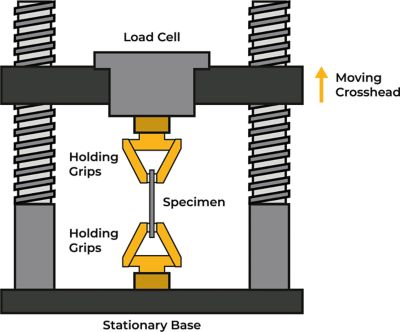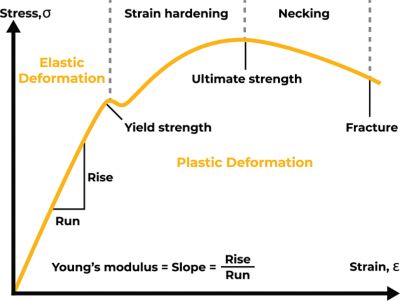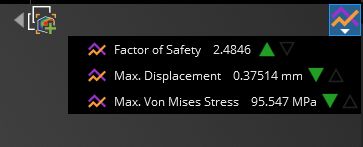-
United States -
United Kingdom -
India -
France -
Deutschland -
Italia -
日本 -
대한민국 -
中国 -
台灣
-
Ansys si impegna a fare in modo che gli studenti di oggi abbiano successo, fornendogli il software gratuito di simulazione ingegneristica.
-
Ansys si impegna a fare in modo che gli studenti di oggi abbiano successo, fornendogli il software gratuito di simulazione ingegneristica.
-
Ansys si impegna a fare in modo che gli studenti di oggi abbiano successo, fornendogli il software gratuito di simulazione ingegneristica.
-
Contattaci -
Opportunità di lavoro -
Studenti e Accademici -
Per Stati Uniti e Canada
+1 844.462.6797
ANSYS BLOG
April 6, 2023
What is Equivalent Stress?
When designing a new component, engineers must pay attention to every single detail of their design, such as:
- What environment will this be in?
- How long will this need to survive?
- How much can this weigh?
- How much does this need to cost?
Quite simply, as engineers, we’re tasked with coming up with solutions to complex problems in a short amount of time, and we must always be hyperaware of every single aspect of our design. But the key focus of many designs comes down to one aspect: structural integrity.
Most engineered parts today experience a wide range of loading conditions from tension and compression to shear, bending, and torsion, all of which result in a complex stress state that is comprehensively described by a three by three tensor. This results in nine different values that you need to review for each portion of your domain. This is where having a concept of equivalent stress is extremely valuable, as it combines these nine values into a single equivalent stress value. Although it is fundamentally calculated from the three by three stress tensor, an equivalent “stress” is technically a scalar value that we use as an index.

Stress tensor.
What is von Mises Stress?
According to the von Mises yield criterion, a given material will not begin to fail as long as the maximum value of the distortion energy does not exceed the distortion energy to require to yield the material in a tensile test. Von Mises stress is an equivalent stress value that is used to determine if a given material will begin to yield, where a given material will not yield as long as the maximum von Mises stress value does not exceed the yield strength of the material. Traditionally, von Mises stress is used for ductile materials, like metals.
From a practical perspective, von Mises stress simply enables engineers to understand the performance of a complexly loaded part with a simple uniaxial tensile test. Results from a theoretical ductile material can be seen below, where we can extract performance parameters, such as yield strength, ultimate strength, and Young’s modulus.

Tensile test diagram.

Tensile test results.
The comparative nature of tensile results and von Mises equivalent stress enables us to quickly calculate functional values, such as a factor of safety. You can calculate this value by simply dividing the maximum allowable stress by the equivalent stress. When using the yield strength as the maximum allowable stress, the factor of safety must be over one for the design to not experience permanent deformation. Quite simply, this factor of safety provides the absolute minimum performance target for the design.
von Mises Stress Equation
Von Mises stress can be calculated from the stress components described by the three stress tensors or from the principal stresses. Either of the below expressions give the same von Mises stress, σv, for a given stress state.

Von Mises Stress equation.
Using Equivalent Stress for Design Exploration in Ansys Discovery
With the truncated timeline of today’s engineering deadlines, it’s imperative that design engineers quickly understand their design's performance and how best to improve it. In Ansys Discovery, design engineers and analysts can simulate multiple different physics, including structural simulations. By using a live-graphics processing unit (GPU) based solver, engineers can quickly visualize the performance of their design and quickly report out key values such as equivalent/von Mises stress. Additionally, users can leverage the Ansys flagship structural solver (MAPDL) to further interrogate their model for high-fidelity results. In the example below, we will be simulating the loading of the fore and aft engine mounts of a fixed wing aircraft.
(Once the models below finish loading, you can zoom in and pan to interact with them.)
Aircraft engine mount assembly.
Under a variety of loading conditions, Discovery can solve for a multitude of performance parameters, including the individual components of stress, principal stress, and, of course, equivalent stress. As mentioned previously, the equivalent stress value is calculated from individual stress components, such as principal stresses. As you can see in the figures below, there are clear similarities between the maximum (red) and minimum (blue) stress value locations between the principal and equivalent stress contours.
Equivalent stress.
First principal stress.
Second principal stress.
Third principal stress.
Combining the capabilities of live physics simulation and integrated geometry modeling, users can quickly iterate their design and see instantaneous physics feedback and engineering parameters, like equivalent stress and factor of safety. With those two known values, engineers can quickly know how close they are to the threshold of material failure.
Additionally, users can take advantage of features like monitors to track and record design progress with each design iteration. In continuing the example above, we modified the design of the first stiffening rib on the front engine mount to try and reduce the equivalent stress. As you can see in the images below, our monitors and contours indicate an increase in factor of safety and a reduction in equivalent stress, quickly indicating to the user that they have reduced the likelihood of their design failing.

Ansys Discovery monitors.
With the combination of integrated geometry modeling and upfront simulation, Discovery provides users with an extremely powerful tool to have in their design engineering toolbox. Simulations like this aircraft engine assembly took less than 10 minutes to import, set up, solve, and iterate.
Are you interested in learning more about how Discovery can revitalize your product development workflows? Explore Ansys Discovery or try it for free.










